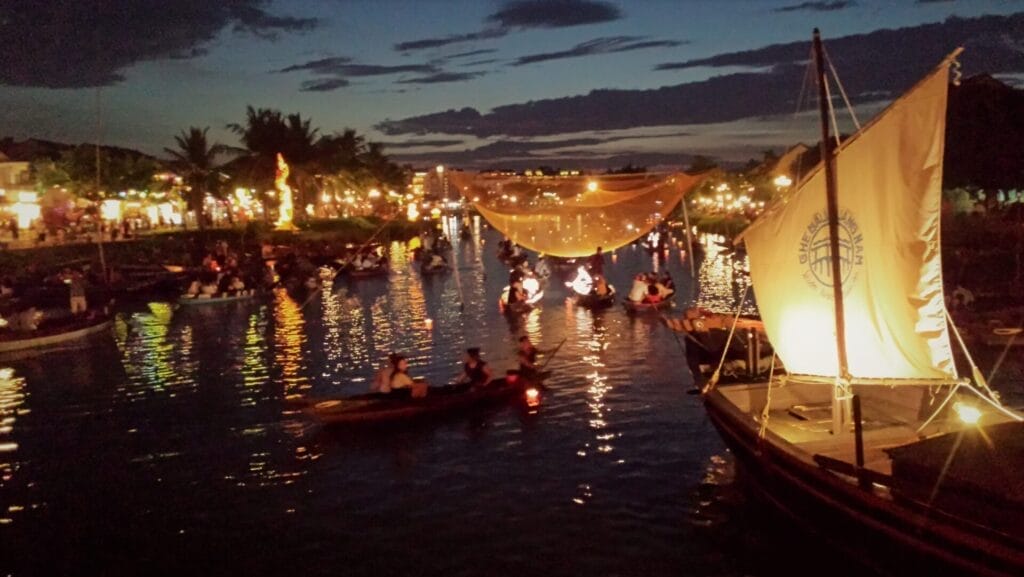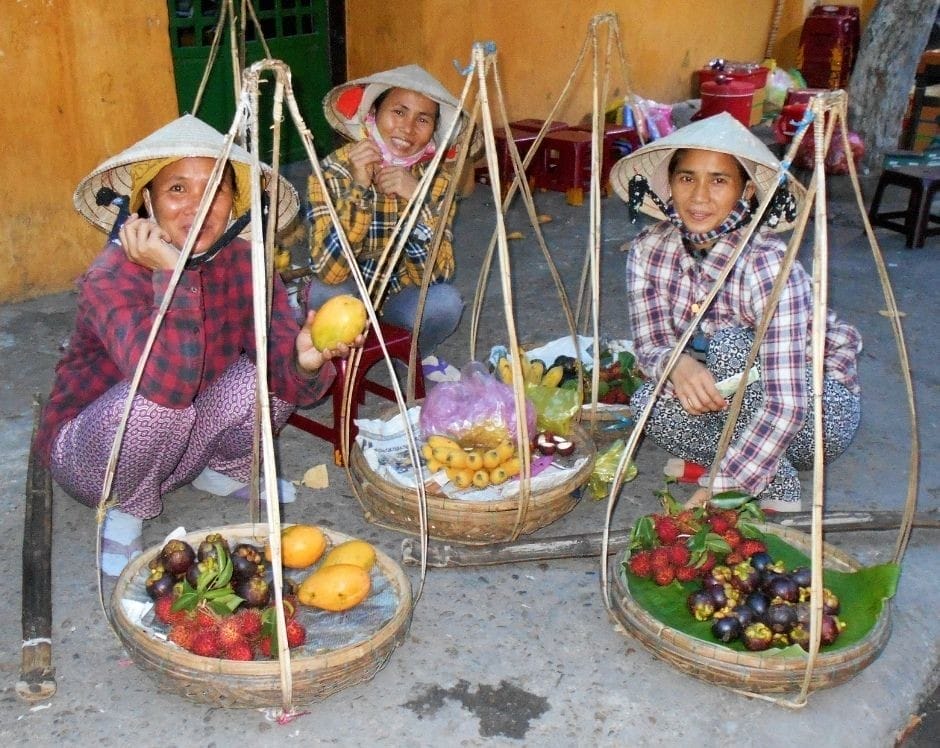BEST TIME TO VISIT HOI AN
If you’re wondering when is the best time to visit Hoi An, you’re already asking the right question, because weather and seasonal rhythm will shape almost everything that you plan to do in Hoi An from beach days to lantern festivals.
In this post, I’ll walk you through Hoi An’s usual weather patterns, the seasonal pros and cons, and how recent floods have affected the ancient town. I’ll also give you clear recommendations – not only on the best time to visit Hoi An but where to stay – so you can plan your visit to Hoi An with confidence at any time.

TABLE OF CONTENTS
- BEST TIME TO VISIT HOI AN
- HOI AN FLOODS
- HOI AN MONSOON SEASON
- HOI AN RAINY SEASON
- HOI AN WEATHER FORECAST
- BEST TIME TO GO TO HOI AN
- RAINY SEASON: CHECK WITH THE HOTEL WHEN BOOKING
- RAINY SEASON: WHERE TO STAY IN HOI AN
- HOTELS IN HOI AN
BEST TIME TO VISIT HOI AN
The best time to visit Hoi An is certainly between February to April, as that time frame in Central Vietnam usually brings mild temperatures, low rainfall, and lots of sunshine, which makes walking the old town, taking boat rides on the Thu Bon River and visiting My Son or the local beaches, far more pleasant.
The mild temperatures between February through April make this a great time for cycling to rice paddies and riding between Hoi An and nearby Cua Dai and An Bang beaches.
Calm seas make this a perfect time for water sports and for visiting Cham Island.

Between February and April you’ll often find good hotel rates and less crowded restaurants and shops. And, if your priority is beach time and you want bright clear days for photography and food markets, then aim for this time in particular.
I’m planning to revisit Hoi An during March 2026. In March, you can expect sun-washed streets and warm drier days (average rainfall less than 50 mm) but manageable temperatures (around 24 – 30C / 75 – 86F) and a lower humidity compared to later months.
Hoi An is usually less crowded in March – still pleasantly busy but not yet as busy as in high-season – and it’s when the town at its most photogenic with one or two Full-Moon Lantern Festivals (depending on lunar dates) and with a slower rhythm of life that will invite you to walk, cycle, take boat trips, and to linger while exploring and sightseeing.
Read my full post on the wonderful things to do and see in The Best Of Hoi An.

HOI AN FLOODS – BEST TIME TO GO TO HOI AN
Typically, I would personally avoid travelling to Hoi An – and Central Vietnam – between September to November, because this is when the central coast gets its heaviest storms and floods – a risk that became painfully real in recent weeks (and at the time of writing).
Recent years have shown that during a Hoi An rainy season the town is vulnerable to intense rainfall and river flooding in the autumn months.
In late October 2025, Hoi An floods were tied to unusually intense rainfall events. Record rains and the river overflows caused severe flooding in Hoi An and across the entire of central Vietnam. Hoi An’s river surged causing hotels and businesses to evacuate.
Emergency responses and clean-up operations in Hoi An were extensive and widely reported in the international news as locals and authorities worked hard to rescue those trapped by rising water levels and to restore the tourism infrastructure in the old town.
Unfortunately, this seasonal pattern means that September to November in Hoi An is not just “rainy” because the region can experience tropical storms and serious river flooding that can affect transportation, accommodation and safety.

HOI AN MONSOON SEASON
Hoi An sits in central Vietnam and has a tropical monsoon climate with two broad seasons:
Dry season (roughly February to August): warm to hot days, lower rainfall. This is when beaches shine and walking the old town is comfortable
Wet season (roughly September to January): more rain, frequent heavy downpours, and a higher chance of tropical storms and river flooding. The rainiest months tend to be in the autumn (September to November).

HOI AN RAINY SEASON
Is it safe and advisable to visit Hoi An in the rainy monsoon season? The short answer is yes, but of course, it also depends on your risk tolerance and what you want out of your trip.
Flood season in Hoi An is quieter and cheaper and some travellers find the moody skies and floating lanterns (lower water levels permitting) atmospheric.
Locals are resilient and many cultural experiences still run when it’s safe. But major storms can disrupt travel and damage infrastructure – as we’ve seen recently – and that’s not usually the kind of experience most travellers want.
So, if you do travel to Hoi An in the rainy season between September to November, it might be prudent to buy flexible tickets, check travel advisories, and consider trip insurance that covers weather cancellations.
I’d also advise you to monitor local news and weather in the days before arrival during September to November. After the recent floods, recovery conditions have changed quickly. News outlets and local tourism sites will report closures and transport updates.
Flexible bookings will allow you to choose refundable hotel rates and changeable travel tickets during the wet season. I like to book with (my affiliate link) Booking.com and choose a cancellation option.
Travel insurance that covers weather-related cancellations and emergency evacuation is a good idea and worth considering if you’re visiting in or near the monsoon window.
If you do visit after floods, it’s an opportunity to support local businesses as spending with local guides, restaurants and tailors will help the community rebuild. Many businesses will reopen quickly with resilience in rainy season and with gratitude for your custom.

HOI AN WEATHER FORECAST – BEST TIME TO GO TO HOI AN
January: End of wet season; variable. Cooler nights. Good for quieter visits if rains have eased. February to April: Prime window. Dry, mild, ideal for sightseeing and beaches.
May to August: Hotter, especially June to August. Good beach weather. Expect heat and humidity. Peak summer crowds in some weeks.
September to November: Monsoon season. High risk of heavy rains and floods. Recent severe flooding in late October 2025 is a reminder to be cautious.
December: Cooler, occasional rain. December is a decent alternative to the busy spring months but watch for variable weather.
SEE MY FULL POST ON THE BEST AND WORST TIME TO VISIT VIETNAM
BEST TIME TO GO TO HOI AN
If you decide to visit Hoi An in the wet season (the rainiest months tend to be in the autumn and between September and November) when you can usually expect more rain, frequent heavy downpours, and a higher chance of tropical storms and river flooding.
I recommend you choose where to stay in Hoi An with care and consideration.
Select a hotel that has good reviews and has experience and protocols in place for flood events (moving guests to higher floor, arranging transport, etc). If the hotel is located by the river, are staff trained and prepared to provide appropriate responses and maintain communication? Is your room or block above a known flood level? What is the evacuation plan if water rises? Do they have back-up power and elevated entrance?

RAINY SEASON: CHECK WITH THE HOTEL WHEN BOOKING
When you contact any hotel, if you are planning a stay during rainy season, you might like to ask the following questions to gauge how resilient they are to flooding:
“What is ground-floor elevation in meters relative to river level or sea level?”
“Have you had recent floods, and what was the impact on the property and guests?”
“Do you have an evacuation or guest-relocation plan if water rises rapidly?”
“Are guest room floors above known historic flood marks?”
“Is the hotel outside the low-lying wards of Cẩm Nam / Minh An / near the Hoài River?”
“Is there backup power, transport options (boat/raised walkway) in case the ground floor is submerged?”
“Is travel insurance or flexibility offered if there is a flood event during our stay?”


RAINY SEASON: WHERE TO STAY IN HOI AN
Here is a list of ten hotels around the Hoi An area of varying budgets and, where available, information and commentary on their flood-resilience or specific location.
This list is based on publicly available information on its location, elevation, past traveller reviews and comments, to help you compare and choose your preferred accommodation in Hoi An. I recommend you always check directly with the hotel for up-to-date status and conditions.
FIND YOUR PERFECT PLACE TO STAY IN HOI AN USING MY INTERATIVE MAP
HOTELS IN HOI AN
Hoi An Historic Hotel: if you prefer being right in the heart of ancient town, Hoi An Historic Hotel is close to the centre of the old town but according to advice on forums is still outside the most at-risk low-lying zone.
Emerald Hoi An Riverside Resort: This resort has a guest review that specifically mentions a recent flood event: “The staff recommended us to stay in a higher level or evacuate to another resort. They arranged boat transport for guests to the airport.”
Almanity Hoi An Resort & Spa: Several traveller forum threads say the Almanity is in an elevated area of Hoi An and “out of the flood zone” but still only 1km from Hoi An Ancient Town.
EMM Hotel Hoi An: This hotel is considered to be a safer choice by experienced travellers, with reference to flood-zone avoidance. “EMM Hotel … out of the flood zone … I have followed a personal rule not to stay in the flood zone from September to mid-December for years.”
Four Seasons Resort The Nam Hai: This luxury resort lies outside the old-town river-zone, being on Ha My Beach (coastal) rather than riverside in the low-lying old town area. Mentioned in an article about post-flood tourism recovery in Hoi An’s region.
Hoi An is one of those places that lives in postcards and memory with honey-coloured colonial facades, lantern-lit nights drifting on the Thu Bon River, and narrow alleyways filled with tailors, cafés and a slow pace of life.
Whenever you plan to visit Hoi An – at whatever time of year suits you best – the weather and seasonal rhythm will almost certainly shape almost everything you’ll do here, from beach days to lantern festivals, to whether your walking shoes get wet and muddy.

I hope you’ve found this post helpful in planning your trip to Hoi An Vietnam.
I love Vietnam – it’s one of my most favourite countries in the world – and I’ve travelled and explored Vietnam several times from the Mekong Delta and Ho Chi Minh City in the South, through the central region of Danang, Hoi An, and Hue, to the North and Haiphong, Cat Ba, and Halong Bay. Click on the box below to see all my posts on Vietnam!




